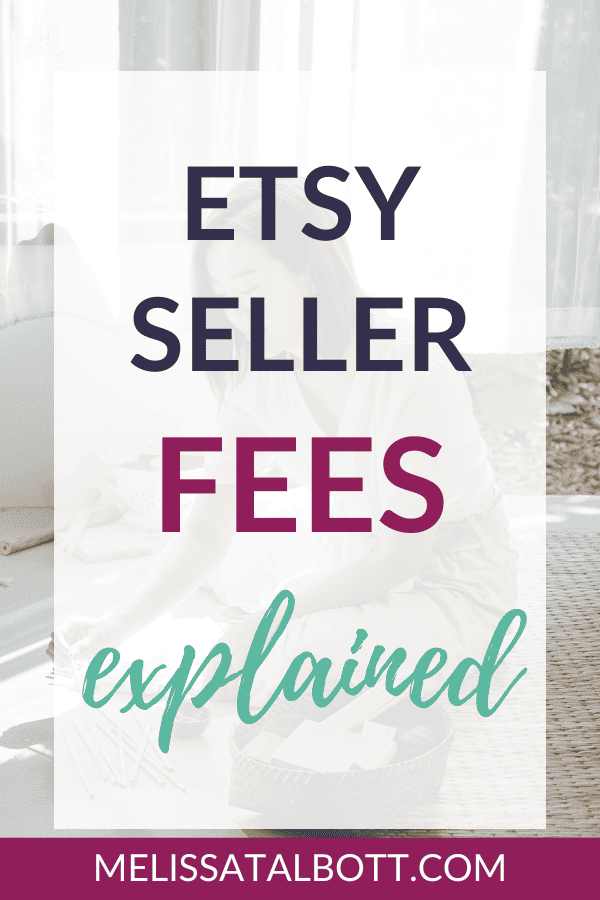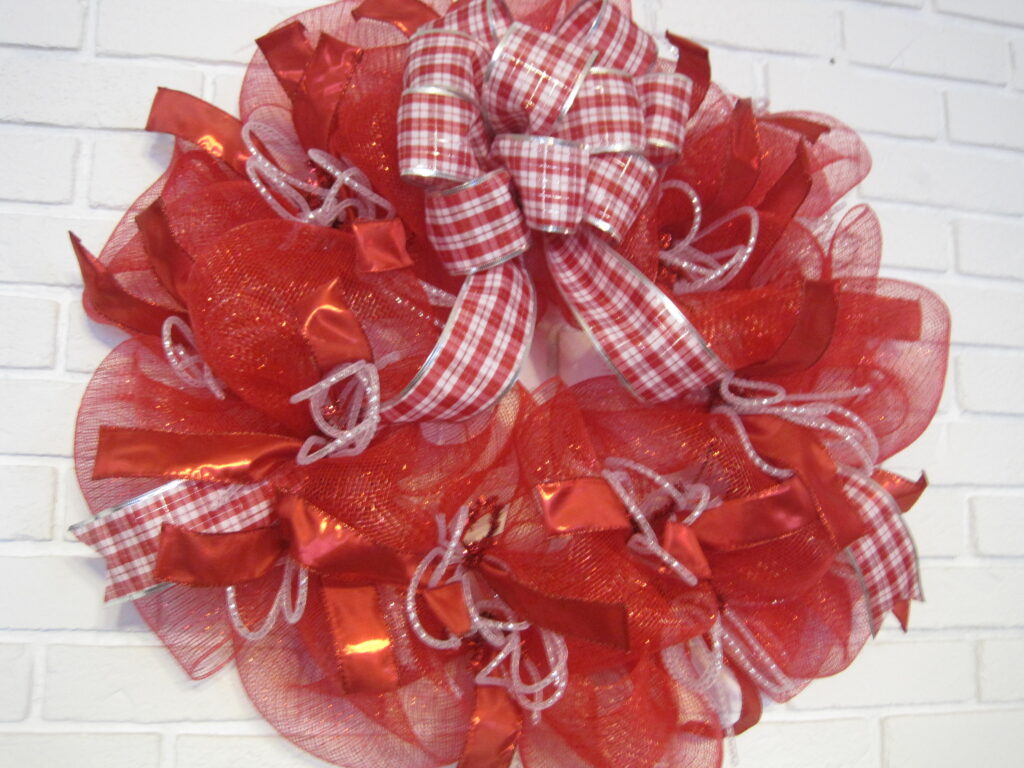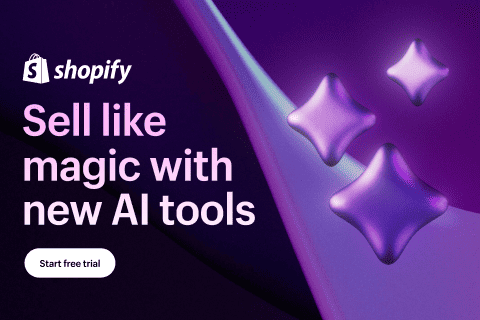If you are just getting started or are thinking about starting an online store, you are probably looking for the best and cheapest platforms to sell on and fees associated with selling on each.
So today, we’re going to dive into the world of Etsy sellers fees. We’ll discuss how much it costs to sell on Etsy and how much Etsy charges (what percentage it takes) for each transaction. We’ll also look at how Etsy fees compare to other common selling platforms. Then, we can determine if it’s worth it to sell on Etsy for your business.

Just a heads up! This blog post may contain affiliate links. That means if you make a purchase through one of those links, at no additional cost to you, I may make a commission from your purchase, which helps me provide this content to you!
How much does Etsy charge a seller?
Etsy Fees
Etsy is like any business and their business happens to be providing a platform for sellers to list their products on and market to Etsy’s buyer base. In turn, Etsy charges fees for that service.
As of April 2022, Etsy charges $0.20 per active listing and 6.5 percent on each transaction (sale/order) that is processed on it’s platform. Etsy does not currently charge a recurring monthly fee.
Etsy Listing Fees
Each time you list a new item and activate that item, Etsy charges $0.20 for that listing. It is considered an advertising expense for your business. Think of it like you are advertising to Etsy’s buyers and this is the fee to get that item out in front of those buyer eyeballs.
Your listing will be active for 4 months. After 4 months, you can chose to renew the listing or let it expire, if you have your listing set to manual renewal. If you have you listing set to auto renew, Etsy will renew the listing automatically and charge you $0.20 again for the listing renewal. It’s then active for 4 more months.
If you’d like to learn why my listings are only set to manual renewal, check out this article when you finish this one.

If you’d like to see some of my free trainings, yep, FREE, you can check them out on my YouTube channel. I cover topics about online business, selling on Etsy and Shopify, digital design, marketing and loads more.
Etsy Transaction Fees
With the transaction fee, this fee is incurred only when a sale/order occurs. Etsy charges a 6.5% transaction fee on every sale that is generated on Etsy’s platform. This is Etsy’s commission for your use of the platform and resulting sales for your business.
Another thing to note here is that the transaction fee applies to both the list price and the shipping. It doesn’t matter if the shipping is included in the retail price or if the shipping is charged separately. The transaction fee will be on the total price.
I’ll give you a way you can save on these fees a bit later.
Etsy Processing Fees
There is one other fee that you need to be aware of and that is the processing fee. But this is not an Etsy fee per say but a credit card processing fee passed on to you, the seller.
The processing fee is a fee that is charged to Etsy (and therefore, you) by the credit card processor for the actual credit card processing, e.i., a fee for the transfer of money that occurs with each transaction.
This is just another cost of doing business. You are using the credit card processing service of another business that wants to get paid too.
If you use any form of credit card processing for your business like a Stripe account, PayPal, Square, etc. those companies all charge a processing fee on money transfers and transactions. The processing fee you see in your Etsy payment account fee section is exactly the same thing.
Anytime a credit or debit card is swiped, chip read or card number manually entered for a transaction, a processing fee is incurred.
Note – a processing fee is NOT the same as a transaction fee. A processing fee is charged by the credit card processing company actually dealing with the money exchanges from different card and bank accounts.
Don’t forget to join my FREE Etsy Seller Success Facebook Group!
Possible changes to Etsy seller fees in the future
Note – I have heard some “rumors” in Etsy seller Facebook groups recently that Etsy is testing charging a fee for brand new accounts. As I haven’t started a new account recently nor seen this publicly announced by Etsy, I cannot confirm that at this time.
If Etsy does move to this model, do not be surprised as this is just one more way for Etsy to verify that the accounts are real, hopefully, not spammers and scammers and is ultimately an attempt to control the riff raff and junk clogging up the Etsy platform and deter the bad actors on the internet and protect you as well.
In recent years, Etsy has gotten a bad rap for mass produced items, scammers and counterfeit items, etc., and this is a measure that they may take to try to remedy the situation.
It also isn’t a huge fee. I was hearing that it was around a $15. You would be paying that much or more on a monthly basis for other platforms, and it sounded like this would just be a one time fee, we’ll call it an “activation” fee until I hear further about it, but Etsy could change to a subscription model like most other platforms in the future so keep that in mind.
I’ll talk about other platforms in comparison in just a bit.
How much does it cost to sell on Etsy?
The total cost of a sale processed on Etsy is $0.20 for the listing fee, plus 6.5% of the total sale for the transaction fee, plus 3% of the total sale plus $0.25 for the processing fee.
* This is the fees for the United States.
Here’s a few examples for you.
| Price Including Shipping | Listing Fee | Transaction Fee | Processing Fee | Total Fees | Your Deposit Amount |
| $2 product (digital item – no shipping) | .20 | .13 | .31 | .64 | 1.36 |
| $5 product (digital item – no shipping) | .20 | .33 | .40 | .82 | 4.18 |
| $10 product (digital item – no shipping) | .20 | .65 | .55 | 1.40 | 8.60 |
| $20 product (plus $5 shipping) | .20 | 1.63 | 1.00 | 2.83 | 22.17 |
| $25 product (shipping included in price) | .20 | 1.63 | 1.00 | 2.83 | 22.17 |
| $50 product (plus $15 shipping) | .20 | 4.23 | 2.20 | 6.63 | 58.37 |
| $65 product (shipping included in price) | .20 | 4.23 | 2.20 | 6.63 | 58.37 |
| $100 product (plus $20 shipping) | .20 | 7.80 | 3.85 | 11.85 | 108.15 |
| $120 product (shipping included in price) | .20 | 7.80 | 3.85 | 11.85 | 108.15 |
If you’re struggling with figuring out Etsy’s fees, you can grab my ETSY LISTING FEE CALCULATOR. Available as printable PDF, Excel spreadsheet and Google Sheets format.
This is a super simple Google Sheet and Excel spreadsheet format that will auto calculate your Etsy listing fees for you! Also, a printable format is included. Easily make sure you are figuring those fees into your product pricing. Know that you will be making a profit once the fee dust settles. I’ve also included a few links to Etsy’s Seller Handbook for additional resources you may find useful.
You might also want to read this article next, How To Price Your Products For Etsy, where I’ll dive deeper into product pricing and pricing formulas.
Now, you may be thinking…
Is selling on Etsy worth it?
Should I start on Etsy, stay on Etsy or find another platform to sell on?
In my opinion, it is worth selling on Etsy for most e-commerce, product-based businesses.
Etsy’s fees are, in most cases, much lower that other platforms, and Etsy does have a large customer base to sell to. Etsy has had some growing pains over the years, but is still a good, viable option for e-commerce businesses.
Again, my answer is the same. Yes, but feel free to disagree if you like.
Why Etsy is good for beginner online sellers.
I feel Etsy is a great starting point for new e-commerce businesses. I know so many business owner who’ve gotten their start on Etsy to go on and build multiple 6 figure and even 7 figure businesses, both on and, later, off Etsy as well.
#1 Etsy doesn’t require a ton of technical know-how, website coding, html or any other technical jargon. You simply create an account, create your products and upload them into Etsy, filling it the item information and you are able to start selling right away.
If you compare Etsy to other marketplaces the user interface is fairly straightforward and simple to navigate. Etsy has spent years making the seller dashboard easier to use and more intuitive.
Is Etsy right for you? Use this link to get 40 FREE listing credits to start your new Etsy shop today!!
#2 Etsy is a marketplace, acting as the marketer for your Etsy shop if you put ZERO effort into marketing and social media advertising yourself. Etsy spends millions of dollars each year to keep buyers coming back and to acquire new buyers.
Many Etsy sellers have relied solely on Etsy to generate full-time incomes, with no outside marketing efforts. I do recommend, however, that you help drive traffic to your shop through social media, etc., as well, as you will see the greatest results when you do.
Why does Etsy charge so much?
From TV ads, Facebook ads, Pinterest, Instagram, TikTok, email marketing and so on, Etsy is spending big money to keep the buyers flowing to the site. It also incurs normal business expenses for employees, customer service, technology, legal fee, etc.
Etsy charges fees to its sellers to ensure it can effectively, safely and legally run the marketplace platform, as well as marketing to potential buyers.
Marketing to buyers
According to Statista.com, “In 2022, the online marketplace company, Etsy, invested roughly 710 million U.S. dollars into marketing activities, up from just over 650 million U.S. dollars in the previous year.”
If you are running a stand alone website, you would have to spend just as much, if not more, time and money just to be in the same ballpark as Etsy for traffic and sales.
I don’t know about you, but my bank account isn’t that big.
This is one of the reasons smaller marketplaces struggle to gain traction as a prominent selling platform.

Etsy gives you access to its shoppers in return for the listing fee and transaction fee. It’s really a simple exchange.
Shoppers and potential buyers = Etsy fees.
The fees will go up over time. More employees and more technology to keep the marketplace safe and our data secure, more marketing expenses, etc.
Marketplace security and safety
Etsy has stated that the fees are also used to invest in helping keep the marketplace safer.
Getting rid of shops that are violating Etsy’s policies. You know who I’m talking about. Spammers and scammers.
Since Covid-19 rocked our world, Etsy has seen a massive increase to the number of sellers on the platform. Many of which do not sell according to Etsy policies for what is vintage, handmade or a supply. They have seen enormous amounts of scammers and spammers among sellers and buyers alike.
To learn more about what you can sell on Etsy, check out this article next.

New technology is constantly being developed and implemented across the internet, Etsy included, to keep websites safe and secure from prying internet eyes. Data such as your personal information, credit card numbers, banking information, etc. that you don’t want just anyone to have access to.
Buyer Protection Plan
Another thing Etsy is promising to working on is resolving issues with buyers.
Etsy instated the Buyer Protection Plan in recent years as well.
Etsy’s buyer protection program was created to help alleviate issues that arose between buyers and sellers. It is mostly focused on resolving complaints and claims regarding shipping issues like late or missing deliveries, items arriving broken and item discrepancies.
Etsy has also seen an influx of scammer buyers as well as sellers. This creates a pain point for both Etsy and the sellers. From packages not being delivered as expected due to major shipping delays around the world to just downright nasty buyers and scammy buyer practices.
How to handle marketplace fee increases?
A few years back Etsy sellers completely lost their minds when Etsy announced that it would be changing its transaction fee from 5% for 6.5%. I really do mean lost it. Saying they would boycott, and many sellers chose to just leave the platform altogether.

Marketplace fee structures change over time.
You need to expect that running a business changes. Expenses will increase and someone will have to pay the bill.
Expect the fees structure of any platform that you sell on to change over time. As the expense of running and advertising selling platforms and marketplace rises, expect those expenses to be passed on to you, the user of the platform. You can either choose to absorb the cost increase or pass it on to your customer.
I don’t suggest you shut up shop just because of a 1%-2% fee increase when fees have been consistent for years. You simply need to make small adjustments to your business when this happens.
It’s no different than when USPS or UPS raise their shipping rates yearly, sometimes bi-yearly even, you will either absorb that cost (which I don’t recommend) or you pass it on to your buyer.
That is totally up to you and how you want to run your business. No one can tell you how you run your business, and any piece of advice, from me or anyone else.
If you truly believe that the fees are too high, then it is your right to leave the platform. But just do it, and don’t cause a ton of fuss about it. No drama needed, just move on.

But in the end, it’s your business to do with what you want. That’s the beauty of being self-employed. You get to make your own decisions – for the most part.
This is my personal opinion here, and again, you can take this advise or decide that it just isn’t right for you.
Should you sell on Etsy?
So, do set up your very first shop on Etsy? Do you stay to course and continue your shop? Or, do you find other platforms to sell on?
For me, I have 3 + established shops on Etsy that pull in a significant income for my business. This is not something I want to give up.
I’m not giving that up over a tiny nominal percentage. I’ll just increase my prices as it’s usually not a huge, significant change. Buyers know now that prices are increasing every day on everything.
Our economies are ever-changing and inflation has been a big bullet to bite for many small businesses in recent years, with increased material costs and shipping costs and the unknowns.
But, for me, I’ve built successful businesses on Etsy and don’t plan on throwing that away for a small percentage increase every once in a while.

And know that there are other options out there as well. You don’t have to be a one trick pony either.
GoImagine, Artfire, Facebook, Instagram, TikTok, eBay, Amazon, Shopify, Squarespace, WordPress and so many more.
How do Etsy fees compare to other e-commerce platforms?
I still see that Etsy’s seller fees are lower than most other platforms.
But if you are still thinking, “Where can I sell instead of Etsy?”, here are the top picks I’m seeing among fellow sellers.
Some of the big ones sellers are using as an alternative to selling on Etsy are Amazon, eBay and Shopify and Goimagine.
Amazon
If you want to sell on Amazon, you need to look into their fees closely. From Amazon Handmade to Seller Accounts to FBA, these all have their own pros and cons and different fee structures are based on the item category being sold or whether you utilized Amazon’s warehouses via Amazon FBA.
Most of the time, Amazon will have higher transaction fees that Etsy. Its a sheer numbers thing here. Amazon is HUGE! Amazon’s customer base is larger than Etsy’s by, let’s just say, A LOT!

Here’s some data to compare from Sale Samurai,
“Before comparing the two platforms, we must first explore their general stats.
- Etsy attracts more than 4.3 million Sellers, while Amazon reports having more than 6.3 million.
- Etsy has around 40 million buyers, while Amazon’s visitors are exceeding 2.44 billion.
- Etsy’s revenue was $1.7 billion in 2020. Amazon’s was $386 billion.”
Want to increase your Etsy income, try Sale Samurai for FREE today.
In exchange, they charge more. It’s strictly numbers here. More customer access, higher fees.
EBAY
eBay is along those same lines as Amazon. Double check all the selling fees that come with selling your particular products, etc.
I will be honest, I don’t sell on eBay so definitely do your own research on that one. I do know there are many successful vintage sellers that sell on both eBay and Etsy.
eBay has also announced fee changes recently as well.
All platforms have different fee structures, and they change frequently so what works today and for years for your business may not always work as your business grows or your business model changes.

Goimagine
Goimagine is a newer platform that has hit the marketplace scene in recent years as an alternative to Etsy.
There are some drawbacks to Goimagine, like a smaller customer base, compared to Etsy, but it is gaining some notice among handmade sellers and worth mentioning here.
The seller fees are different from Etsy’s fee structure as well. Goimagine is structured more like Shopify with a recurring monthly fee, but no individual listing fees. It has has a scaled 5% transaction fee compared to Etsy’s 6.5%.
Comparing Goimagine’s monthly subscription/ membership fee to Shopify’s, it is significantly cheaper at only $2.50-$10/month instead of the $29+/month on Shopify. You can also get a custom domain with the Mosaic plan on Goimagine.
Get one month free on Goimagine with my referral code 5YF0QT.
SHOPIFY
Shopify Fees
With Shopify, the fee structure is not the same as Etsy. Shopify’s fees are reasonable, at least to me, though. In fact, I have one of our e-commerce stores hosted on Shopify.
So, let’s take a look at it a little closer.
- Shopify has a base plan that currently starts at $29 per month, if you pay yearly or $39/month if pay monthly.
- It does not charge a commission on your sales.
- There is, however, still a credit card processing fee very similar to Etsy’s processing fee.
Comparatively, Etsy charges $.20 per listing just to show it on the platform. Shopify has no listing fee per item, instead it has the $29 monthly fee.
Let’s break this down a bit.
How many sales would you need to break even when comparing Shopify’s monthly fee to Etsy’s listing fees?
We can work backwards here.
$29 divided by $.20 equals 145.
If you generate more than 145 sales per month (.2×145=29) you would possibly be saving money with Shopify. $.20 listing fee x 145 sales = $29.
Anything over 145 sales, you could begin to save money with Shopify when compared to Etsy. This is a simple breakdown is just on listing fees alone.
Also, Etsy then takes a 6.5% transaction fee on the sale price of those 145 sales. So, that would potentially be even more money saved if you have the same number of sales on Shopify vs Etsy.
Give Shopify a try for $1 today.
Unlimited number of products
One other bonus to using Shopify is that you can list a many items as you want at no additional monthly fee or fee per product added to your store!

If you listed 146 items on Etsy it would cost $29.20 in listing fees. On Shopify, it would still only be the $29 for the month. You could add 1000s of products, and it is still only $29/month!
But this is ONLY if you are able to get the traffic needed for acquire that many sales per month. You need to generate more sales to offset the cost on a per month basis.
Another thing to note that is markedly different about hosting your own website on Shopify vs a marketplace store, is marketing.
Marketing a Shopify store
Marketing a Shopify store is, by far, harder than marketing an Etsy shop. It’s like comparing apples to oranges. With Amazon, eBay, Goimagine and Etsy, they are all marketplace. Shopify is not. With Shopify, it is entirely up to you to get the buyers to the cart.
Shopify does not have a built in, warm potential buyer pool to show your products to. You will need to do all the marketing yourself.
From buyer click-through on social media and ads, to buy buttons, add to carts and, finally, checkout. This is ALL ON YOU.
It is much harder to get customers in the proverbial door of your website than it is on a marketplace. Running your own independent e-commerce store is a large monetary and time commitment to get it fully up and running and attracting customers who are willing to open their wallets.
So, if you are a marketing master, you’re willing to put in the extra work and you can get your efforts to convert into sales, this may be an option for you.
Give Shopify a try today for just $1.
Again, a Shopify store would need more effort in the marketing department for your website than is needed for Etsy’s marketplace site. That’s the big trade off.
Can I sell on more than one website or marketplace?
Ab-so-freaking-lutely!!!!!
And I would encourage you to do so if you can financially support it and if you have the bandwidth to handle more than one platform at a time.
You can sell on as many websites and marketplace as you want unless expressly prohibited by a platform.
Pros of selling on multiple platforms
Running multiple shops on different platforms means you could have multiple revenue streams, potentially earning more money.
You also won’t have all your eggs in one basket if one goes down.
That has been a major complaint of some sellers when their Etsy shop is shut down unexpectedly and without warning. Check here to see if you are at risk of having your Etsy shop shut down.

Cons of selling on multiple platforms
The biggest downside to selling on several platforms is that your time and attention is split.
This causes you to have less focus on any one product or business task. It will also cause you to feel more overwhelmed quickly and potentially lead to burnout faster.
Are you on the road to burnout?
But, along with that does come double (or more) the work, customers, messages, shop maintenance, etc.
If you are looking for part-time income, I would NOT suggest selling on multiple platforms. I would stick with one or two max for part-timers and hobbyist sellers.
Building another storefront on another platform is time consuming. Think about how long it took you to start your first online store.
But, if want to significantly increase your income potential, this could be a great option for you. Again, you will be taking on a lot of work to get each up and running smoothly.
Also, most platforms do not allow you to “merge” your inventory from one site to another so you will have to maintain inventory independently as well.
Running stores on different platforms could be a challenge. No two are alike and each has its own learning curve and terms of service.
As a whole, Etsy is a good place to get your foot in the door with e-commence with a lower fees structure and user-friendly dashboard. If you think that Etsy is the right fit for your budding product-based business, I hope you’ll give it a try.
Don’t forget… You can get start with 40 free listings today!
Don’t forget to request to join the FREE Facebook group.







